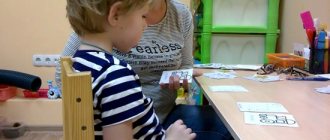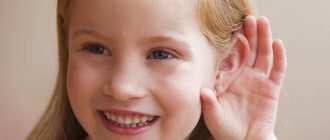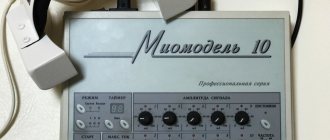Every parent wants their child to develop and grow normally, without any delays or disturbances. However, today's children are exposed to various factors that, to one degree or another, adversely affect their development. First of all, this concerns the child’s speech. Numerous surveys and statistical data show that every second child has speech problems, some to a greater extent, and others to a lesser extent.
And the problems concern not only the correct pronunciation of words; some children do not speak at all until preschool age, but only use gestures. In any case, no matter what problems a child has with speech, it is necessary to seek help from a speech therapist at the first symptoms.
So, what factors influence the development of a child’s speech and what needs to be done so that this problem does not affect you.
The main causes of delayed speech development
Insufficient communication with the child
The first and most significant reason for a child’s speech delay is that parents do not pay due attention to him and have little contact with the baby. In fact, a child needs communication, even if he does not yet know how to speak. From the first days of life, he begins to “absorb” all words, habits and actions from his parents. The more mom and dad talk to the child, the better. Tell him more fairy tales, sing children's songs, communicate with each other in the family. Thus, the child will imitate his parents and begin to speak fully without disturbances.
Equipment and gadgets
The second reason, oddly enough, is the use of modern technology for educational purposes: smartphones, televisions and computers. Sounds strange, doesn't it? But in fact, today a gadget is a “parasite” in a person’s life. We cannot live without our phones, Internet access, or our favorite TV program or series. Even in raising a child, parents often resort to the use of technology. Do you want to drink a cup of coffee and relax? No problem! You can sit your child in front of the TV, turn on a cartoon and forget about it for a couple of tens of minutes. But what happens to the child at this time? His nervous system is excited, thereby inhibiting the development of the speech apparatus. Silence and freedom are, of course, good, but the child and his development should come first, so do not resort to this method of education, but rather read him an interesting children's book.
Lack of reading culture
The second reason for the child’s poor speech development leads to the third – the child’s reluctance to read. Reading books is a fundamental factor in education. As mentioned above, when we talk to a child and read children's books to him, he begins to remember everything and try to repeat it. Accordingly, the more time we devote to this, the better. Buy good children's books: fairy tales, educational magazines, poems. The main thing is that the book has a good and instructive meaning, then you will bring more benefits to the upbringing and development of your child.
Excessive attention to the child
Oddly enough, constant attention and intense care of a child can make him reluctant to talk. And this is another factor in speech impairment. How does it manifest itself? Very simple! Have you ever noticed that your child talks much louder in kindergarten than at home? This is due to the fact that they understand him little and do not know his preferences, so the child needs to talk in order to achieve what he wants, to be played with or given something to eat. And at home, mom and dad ask only questions to which the baby answers “yes” or “no,” since they know their child’s preferences. Therefore, it is necessary to provoke the child into dialogue; talk to him more so that the child gives you a detailed question.
Disturbances in physiological development
And last, but not least, the reason for the late development of speech is physiological reasons that do not depend on the parents. Speech problems may be associated with weak tongue muscles, hearing loss, other congenital characteristics, as well as hypoxia during childbirth and the specific course of pregnancy. All this can be corrected either with surgery (for example, cutting the frenulum) or with the help of a speech therapist.
So, having dealt with the reasons affecting the development of a child’s speech , you need to understand what to do if this problem does affect you.
The problem of speech development of children of early preschool age: theoretical aspect
“Scientific aspect No. 2-2019” – Humanities
UDC 376.01
Yakusheva Veronika Vladimirovna – Candidate of Pedagogical Sciences, Associate Professor of the Department of Special Pedagogy and Psychology of Smolensk State University.
Kachyarauskene Ksenia Vadimovna – master’s student at Smolensk State University.
Abstract: The article discusses modern approaches to assessing the development of speech in young children, presents the stages and periods of speech development in children, and also examines the delay in speech development in the works of scientists.
Key words: Speech, speech development, early age, delayed speech development, dysontogenesis.
Early childhood is considered in pedagogical and psychological literature as a key stage of human development, determining the success of physical, psychological, emotional, and social development. The period of early childhood is one of the most significant periods of a child’s life: the period of rapid sensory development, visual and effective thinking, the formation of the second signaling system and its main functions, the initial formation of the child’s personality.
According to world statistics, currently the number of young children with delayed speech development has increased significantly. This category of children has a history of a burdened perinatal period associated with an unfavorable course of pregnancy and childbirth in the mother. Most often, the neurological status of these children is due to the following diagnoses: minimal cerebral dysfunction, perinatal encephalopathy. In this regard, this category of children in modern defectological science is called a “risk group” [2, p. 111].
A child’s speech development is one of the most important indicators of his harmonious development. The quality of use of language skills determines the effectiveness of communication. The development of speech in ontogenesis is, in a way, the “foundation” on which the subsequent formation of articulatory and other abilities is built.
The gradual formation of speech during its normal development is found in numerous studies by various authors. In the monograph by A.N. Gvozdev [5], in the works of A.N. Leontiev [10], the formation of speech in children, starting from an early age, is described in detail.
A slightly different view on the periodization of speech development is presented in the studies of authors of the twentieth century: the number of stages varies significantly, moreover, the classification of the authors reveals their belonging to different scientific directions. Taking into account the peculiarities of the biological and social development of the child’s personality, E.N. Vinarskaya identified the following communicative and cognitive periods of childhood: “infant cries (0 months -2-3 months), humming (2-3 months - 5-6 months) early babbling (5-6 months -9- 10 months), babbling pseudowords (9-10 months – 12-14 months) and late melodic babble (12-14 months – 18-20 months)” [3, p.20].
Normally, children’s speech development goes through several age stages:
- pre-speech, from birth to one year, when the child masters humming, babbling, and builds up a passive vocabulary (understanding of words);
- the stage of primary language acquisition, lasting from one to two years, when the child first writes 20-50 words and a phrase appears in his speech;
- the stage of mastering the grammar of the native language (2-7 years), when the child masters the complex system of forming sentences, changing words by gender, case and number.
Speech as a higher mental function in ontogenesis arises much later than all higher mental functions, therefore any pathological deviation in the development of a young child, first of all, negatively affects his speech development. In such cases, speech development is either inhibited or follows a different, often disrupted, path.
A correct understanding of this state of speech dysontogenesis, which can be interpreted as “deviations of speech development” or “deviations in speech acquisition” [15, p. 90] at an early age, timely identification of deviations in speech development (when mental processes are in the initial stages of formation), differentiation of deviations from tempo variants of individual speech development, are quite relevant problems of modern special pedagogy.
In the research works of E.V. Sheremeteva gave a typology of deviations in speech acquisition. Deviations in speech acquisition differ in etiology, severity and manifestations. According to the degree of severity, three types of deviations in speech acquisition are distinguished: pronounced deviations in speech acquisition; pronounced deviations in speech acquisition; mildly expressed deviations in speech acquisition. Based on etiology and manifestations, the following types of deviations in speech acquisition are distinguished: deviations in speech acquisition, which are caused by underdevelopment of the psychophysiological components of speech; deviations in speech acquisition, which are caused by underdevelopment of the cognitive components of speech [15, p. 90].
In speech therapy, “speech development delay” (SDD) [8, p. 5] means untimely mastery of spoken language by a child under 3 years of age. This disease manifests itself with insufficient development of vocabulary in quantitative as well as qualitative terms. It is important to know the symptoms of the pathology in order to begin correcting it in time, as well as the possible consequences of untimely therapy.
With this disorder, there is a delay in expressive speech - the absence of phrasal pronunciation by the age of 2 years, and by the age of 3 - the inability to pronounce complete sentences.
Delayed speech development, as a term, is used only for children under 3 years of age, as it is associated with insufficient development of early speech ontogenesis. Typically, pathology is characterized by a condition in which there is a lag in the development of not one component of speech, but all of them at once: pronunciation, vocabulary, the ability to phrase and coherently verbally reflect thoughts.
The following symptoms may be manifestations of delayed speech development:
- incorrect course of the period preceding the development of formal speech communication (insufficient pronunciation of walking sounds, babbling, uniformity of sounds or their complete absence);
- lack of response to the pronunciation of sounds or speech at one year of age;
- at 1.5 years - insufficient repetition of sounds after other people, low activity with echolalia, failure to imitate;
- inability in children aged 2 years to repeat actions after other people or perform simple tasks;
- inability to pronounce whole words at 2 years of age;
- at 3 years old – the child’s inability to form simple phrases or sentences, or connect words together (delayed expressive speech);
- absolute absence of speech of any quality and volume at 3 years (except for repetition of previously memorized phrases);
- using facial expressions and gestures to a greater extent in communication to reflect the reality of the child’s emotional state.
Some children with delayed speech development are able to independently reach the norm of speech development and their condition can be interpreted as temporary and reversible. In other children, the same disturbances in the development of speech can be characterized as underdevelopment in the linguistic and cognitive spheres, which will later lead to speech disorders in preschool age. There are several points of view on the interpretation of the concept of “speech development delay”. Let's look at some of them. So, Yu.F. Garkusha identifies delayed speech development as a systemic disorder that affects higher mental functions, the development of analytical systems and suggests various causes and mechanisms of its occurrence [6, p.45].
T.I. Meerson, A.V. Petryaev and A.V. Pleshakova, in her psychological and pedagogical research, found that children with speech disorders have unique characteristics of general psychomotor. This determines the need to develop and introduce into the system special tasks, exercises and techniques for correctional pedagogical influence, which is carried out in order to completely normalize the child’s speech and other functions [11, p. 181].
Yu.A. Pokrovskaya considers delayed speech development as a systemic defect. In her opinion, when speech development is delayed, not only speech as an activity is disrupted, but also other mental processes. Understanding the patterns of early childhood is of particular importance for special pedagogy and special psychology, since it is at this time that a “deviant” type of development often begins to form. The development of a child’s speech with delayed speech development differs from normal only in its pace, while the patterns of formation of lexico-grammatical structures of speech correspond to normal ontogenesis [13, p. 211].
Speech therapists-practitioners N.I. Petrukhnenko and S.A. Saprykin believe that by the age of two a child’s vocabulary is 130–200 words, and by the end of the third year – 800–1300 words. The child can already tell short episodes and stories and the questions “why?” begin to dominate. And How?". Girls are often ahead of boys in speech development. The main role is played by the child’s verbal communication with adults. People around the child (parents, teachers) should talk a lot with the children, pronouncing sounds clearly and correctly. You cannot distort the language by imitating children’s speech, as this can slow down the process of speech development [12, p. 242].
Thus, if you do not timely correlate the child’s age with the level of his speech development, then there is a very high probability of missing the first signs of speech difficulties, which can later lead to serious consequences. If there are speech disorders, the child has insufficient development of certain speech functions, mental and cognitive processes. In order to overcome and correct the child’s speech development, parents and teachers can use play methods and techniques for speech development, since it is play activity, being the leading activity at this stage of development, that is fully suitable for solving this problem.
Statistics around the world indicate a constant increase in the number of children with delayed speech development, and unfortunately this trend continues [9, p. 12]. We have to admit that in widespread practice, targeted work on the development of speech in young children is just beginning to be introduced into the system of measures to provide early assistance to children with disabilities.
In the technique developed by G.V. Dedyukhina and E.V. Kirillova, presents a generalized experience of the speech therapy service of a psychoneurological sanatorium, where assistance is provided in the following areas: drug treatment, speech therapy and psychoneurological assistance, physical therapy, massage. Such versatile assistance provides a comprehensive approach to the correction of speech disorders. Speech therapy assistance is provided in the following areas: development of attention, active speech, formation of correct speech breathing, development of auditory perception, understanding of the speech of others. The authors note the importance of a positive attitude of the child and adults during classes, praise and a patient attitude towards failures in working with a child [4, p.12].
L.N. Smirnova identifies the following areas of correctional work with young children: the formation of a phonetic-phonemic base, the development of coherent speech, speech motor skills, the activation of sensory development, the development of higher mental functions, cognitive activity, the formation of social adaptation processes. Classes provide active speech training that develops children's speech activity in conditions of emotional comfort. It is proposed to use rhymed texts, which serve as a catalyst that includes speech images in the work [14, p.23].
Method L.N. Efimenkova is aimed at children with general speech underdevelopment, I, II or III levels of speech development. The author has developed methodological techniques for the formation of phrasal and coherent speech in children with speech pathology. The technique involves carrying out correction work in three stages. [7] At each stage, work is carried out to expand the vocabulary and form phrasal speech. The first stage includes the education of children’s speech activity, the formation of passive and active vocabulary, the main tasks of the second and third stages are the formation of phrasal and connected speech, respectively [7, p. 24].
Correctional speech therapy work according to the method of E.F. Arkhipova is built in stages and involves the inclusion of gradually more complex exercises aimed at developing the emotional, sensory, cognitive spheres, normalizing the state of the muscles of the articulatory apparatus, stimulating voice and speech activity, and developing speech understanding [1, p. 22].
Elena Yanushko’s methodology has the main goal of “talking” the child, giving impetus to further development, and describes speech therapy classes and special speech therapy techniques that take into account the specifics of working with young children who have delays in speech development. And it provides the following directions in working with children: the development of communication and cooperation with adults, the development of auditory perception, the development of breathing, the development of hand motor skills, the development of speech [16, p. 60].
Thus, speech therapy work with young children has a number of features and differs from work with older children. It uses a number of techniques to increase the duration and effectiveness of classes, to create and maintain a positive emotional mood in the child throughout the lesson. Currently, methods are emerging that are aimed at working with young children and are the basis for carrying out correctional and developmental work aimed at overcoming delayed speech and psychomotor development in young children developing in conditions of dysontogenesis.
Bibliography
- Arkhipova E.F. Speech therapy work with young children. M.: AST: Astrel, 2006. 222 p.
- Borovtsova L.A., Kozodaeva L.F. Prevention of speech disorders in young children // Psychological and pedagogical journal Gaudeamus. 2015. No. 1 (25). pp. 111-120.
- Vinarskaya E.N. Early speech development of a child and problems of defectology: Periods of early development. Emotional prerequisites for language acquisition. M.: Education, 1987. 159 p.
- Dedyukhina G.V., Kirillova E.V. Learning to speak. 55 ways to communicate with a non-speaking child. M.: Techinform MAI, 1997. 88 p.
- Gvozdev A.N. From first words to first grade: Diary of scientific observations. M.: KomKniga, 2005. 320 p.
- Garkusha Yu.F. Notes of speech therapy sessions with children 2-3 years old: Textbook. M.: PARADIGM, 2013. 160 p.
- Efimenkova L.N. Formation of speech in preschool children. M.: National Book Center, 2015. 56 p.
- Zhukova N.S., Mastyukova E.M., Filicheva T.B. Speech therapy. Overcoming general underdevelopment in preschool children. Ekaterinburg, 2003.
- Lazurenko S.B. Mental development of children with health problems at an early age. Monograph. M.: Logomag, 2015. 256 p.
- Leontyev A.A. Fundamentals of the theory of speech activity. M.: Nauka, 1974. 368 p.
- Meerzon T.I., Petryaeva A.V., Pleshakova N.P. Modern teaching methods in speech therapy work // Current problems of modern education: experience and innovation. Materials of the scientific and practical conference (correspondence) with international participation. Executive editor: A.Yu. Nagornova. 2015. pp. 181-185.
- Petrukhnenko N.I., Saprykina S.A. Speech development in young children // Innovative pedagogical technologies: materials of the International Scientific Conference (Kazan, October 2014). Kazan: Buk, 2014. pp. 242-243.
- Pokrovskaya Yu.A. Definition of “speech development delay” in modern speech therapy / Special pedagogy and special psychology: Collection of scientific articles by participants of the V international theoretical and methodological seminar on April 8–9, 2013, ISO and KR GBOU VPO MSPU. In 2 volumes. Volume 1. Special pedagogy and special psychology: modern problems of theory, history, methodology. M.: LOGOMAG, 2013. 284 p. pp. 211-218.
- Smirnova E. O. Psychology and pedagogy of play: textbook and workshop for academic bachelor’s degree. M.: Yurayt Publishing House, 2017. 223 p.
- Sheremetyeva E. V. Diagnosis of psycho-speech development of an early age child. M., 2013. 112 p.
- Yanushko E.A. Help your baby talk! Speech development of children 1.5–3 years old / E.A. Yanushko. – M.: Terevinf, 2013. 192 p.
Interesting article? Share it with others:
Speech development of a child in Volgograd
As mentioned earlier, the main thing is to work with the child, talk to him more, read children's books. Parents can familiarize themselves with books on speech therapy and try to start working with their child themselves. Perhaps something will come of this. But you shouldn’t rely only on your own strength. Still, a professional specialist will cope with this problem much more efficiently and quickly. Therefore, if you yourself are not confident in your abilities, then contact professional speech therapists. Our Center has created all the necessary conditions for successful correction of general speech delay in children.








